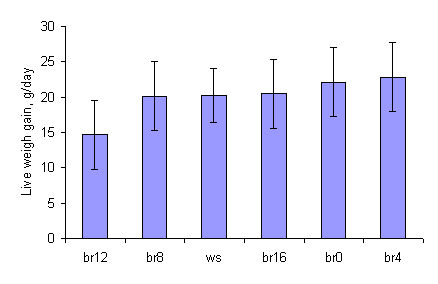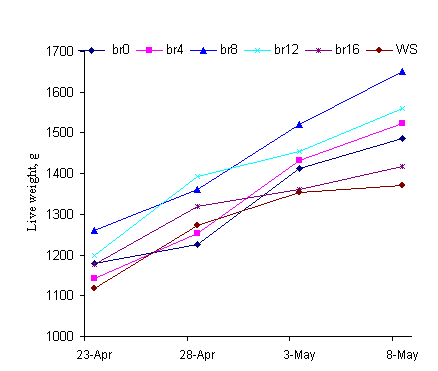Water spinach as the basal diet of growing
rabbits
Vo Thi Tuyet Nga
An Giang University
Introduction
Water spinach is a plant which produces high yields of
protein-rich biomass when fertilized with effluent from
biodigesters (Kean Sophea and Preston 2001; Ho Bunyeth 2003). The
rabbit is a meat-producing animal which is specially well adapted
to utilization of protein-rich foliages due to the nature of its
digestive system in which enzymatic digestion (in the stomach)
precedes microbial fermentation (in the caecum). Premininary
results from Cambodia (Miech Phalla 2002, unpublished data)
indicated growth rates on a diet of ad libitum water spinach and 20
g/day of broken rice of up to 20 g/day, which is within the normal
range for rabbit performance in the tropics. However, more recent
observations (Hongthong Phimmasan 2004)
indicate growth rates in the range of 19 to 28 g/day with no
response to levels of broken rice beyond 5 to 10 g/day. Such a
production system appears to be very appropriate for small scale
farmers with limited land resources as the highly productive water
spinach can be grown on a relatively small area.
Other recent information indicates that the crude protein of
water spinach can be increased to over 30% in the dry matter of the
leaves when the plant is fertilized with biodigester effluent (Ho
Bunyeth 2003) or with urea (Ly Thi Luyen 2003).
Further work on the use of water spinach for rabbit production
is therefore needed in view of the potential of the system for
increasing the income of small scale farmers with minimum outside
inputs.
The hypothesis
The hypotheses to be tested are that growth rates and feed conversion rates in rabbits will be improved when water spinach is supplemented with increasing quantities of broken rice in the range of 0 to 16 g/daily.
Materials and methods
The experiment was started on 23 April 2004 in the experimental farm of An Giang University.
Treatments, animals and design
The treatments are levels of broken rice (0, 4, 8, 12 and16 g/day), mixed
with 100 g of fresh duckweed, offered as supplements to a basal diet of fresh
water spinach. A control treatment receives only the water spinach basal diet.
There are 20
individually-penned rabbits in the experiment with 3 rabbits on each treatment,
except for the control in which there are 5 rabbits..
The rabbits were allocated to the cages on a randomized basis.
Feeding system
Leaves attached to stems of water spinach are hung in the cage, by tying them
to a bamboo stick over the cage. The broken rice is mixed with 100 g daily of
fresh duckweed and was given in a bowl which was tied to
the cage. Water was freely available in each cage. The rabbits were adapted to confinement in individual cages during a preliminary
period of three days after which the experiment was started.
Measurements
Measurements were made of daily water spinach offered and refused (leaves and stem
proportions are estimated daily, and weighed separately for the
refusals)
Statistical analysis
Growth rates of the rabbits were calculated as the slope of the linear regression of live weight (y = g) on time in the experiment (x = days). The data were analysed using the GLM option of the ANOVA software of Minitab (version 13.2). Sources of variation in the model were: treatments and error.
Results
The growth rates over the first 15 days of the trial were in the range of 15 to 22 g/day and were not related to the amount of broke rice offered (Figure 1).

Figure 1: Growth rates of rabbits fed a basal diet of water spinach and restricted quantities of broken rice
The growth curves on the different treatments (Figure 2) indicate consistent increases in live weight during this early period of the trial.

Figure 2: Growth rates over the first 15 days of the trial of rabbits fed a basal diet of water spinach and low levels of broken rice
References
AOAC 1990 Official Methods of Analysis. Association of
Official Analytical Chemists. 15th edition (K Helrick
editor) Arlington pp 1230
Ho Bunyeth 2003: Biodigester effluent as fertilizer
for water spinach established from seed or from cuttings; Retrieved,
from MEKARN Mini-projects.
Hongthong
Phimmmasan, Siton Kongvongxay, Chhay Ty and Preston T R 2004: Water spinach (Ipomoea aquatica) and Stylo 184 (Stylosanthes guianensis
CIAT 184) as
basal diets for growing
rabbits.
Ly J, Nguyen Van Lai and Preston T
R1997 A study of washing losses and in vitro gas
production characteristics of nine leaves from tropical trees and
shrubs for ruminants. Livestock Research for Rural Development (9)
3; http://www.cipav.org.co/lrrd/lrrd9/3/ly93.htm.htm
Ly Thi Luyen
Kean Sophea and Preston T R 2001 Comparison of biodigester
effluent and urea as fertilizer for water spinach vegetable. Livestock
Research for Rural Development (13) 6; http://www.cipav.org.co/lrrd/lrrd13/6/Kean136.htm
UndersanderD, Mertens D R and Thiex N
1993Forage analysis procedures. National Forage Testing
Association. Omaha pp:154